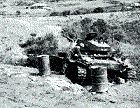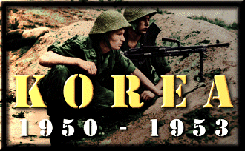The Fight for Gloster Hill

On the morning of the 24th April, the Glosters and their attached personnel were concentrated on Gloster Hill and numbered less than 40 effective fighting men. The relief troops were halted 6km south at the old F Echelon area When the Chinese blew up one of their light tanks and blocked the road. The Glosters had only short supply of water, most of which was reserved for the wounded, but worse was the fact that only 10-15 hours of battery life remained for the battalions radios. Without these the Artillery would not be able to accurately place defences fire for the Glosters.

A supply drop from Sentinel light aircraft occurred at dusk and Lieutenant Colonel James Carne was also informed that ground-attack aircraft, hitherto engaged elsewhere, would be available to support the Glosters the following day. The Chinese attacks began at 2200 hours and continued throughout the night and the Chinese demonstrated that they had learned nothing from the massacre of the previous night. Carne personally routed several enemy parties which made it through the defences earning himself the Victoria Cross and the American Distinguished Service Cross.

At first light, the Chinese were seen to mass for their final attack in their hundreds. Bugles braying, the Glosters one remaining bugle answered with every tune except Retreat. Seven times during the nest hour the enemy closed in to finish off the Glosters, and each time they were thrown back down the hill. At 0830 hours in 25th April the last radio battery died ad the artillery link was severed, although the guns at that time were also under fire and having to move position. Fortune smiled. At this precise moment a flight of Lockheed F-80 Shooting stars arrived and proceeded to burn the Chinese off the hill with napalm before raking the survivors with cannon-fire. A dozen more Shooting Stars followed shortly afterwards to strafe between the hill and river. Leaving their wounded behind in the care of Captain R.P. Hickey, the medical officer and the Chaplin, Captain The Rev. S.J. Davies and their helpers, the survivors made a breakout for the UN lines. Only a handful escaped capture, 58 Glosters had been killed in the three-day battle, 30 more died in captivity and only 63 men reached safety.

The survivors formed the core of the rebuilt 1st battalion as Glosters returned from medical leave, instructional courses and local leave in Japan and on 8th May the 1st Battlion, the Gloucestershire Regiment, and C troop, 170 Independent Mortar Battery were honoured with a US Presidential Citation. The remainder of the 29th had fought an equally epic battle. At 1030 Hours, Brodie was ordered to withdraw in line with the general withdrawal being executed by I Corps. The C Squadron of the King's Royal Irish Hussars tanks provided the Fusiliers with vital armoured support in poor visibility and provided a rearguard for the retreating Fusiliers and Ulsters. The Chinese repeatedly tried to smother the Centurions with their human-wave tactics, vast swarths were cut down by the co-axial machine guns and 2-pounder cannons. Several Centurions which reached safety were covered in blood from both enemy dead and UN troops who had been killed in the hail of Chinese fire, Five tanks were lost. Three to enemy fire.

29th Brigade had lost a quarter of its men, but remained capable of battle. The Chinese 63rd Army had lost 40% of its men, 11,000 casualties and it was pulled out of the line at the end of the day. The Chinese plan was in ruins. By the end of April, the Communists had suffered 70,0000 casualties, the UN only a tenth of that figure. Members of the Glosters who were captured after the battle remained prisoners of the Communists until the end of the war. Many did not return.



